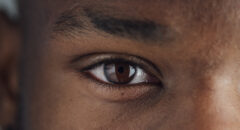
For many people, their eyeliner routine gives them a chance to add flair and really cement their fashion personality. According to a new study, though, the way you swirl that eyeliner brush could be detrimental to your eyes. Since the last thing you want to do while showing off your style is to put your vision at risk, it’s important to know what you might be doing wrong. The good news is that you can fix it without throwing your makeup out the door.
What the Study Says
According to the study, the main issue with how you apply eyeliner is when it migrates into what is known as the tear film. The tear film is a thin protective coating that covers the cornea of the eye. It consists of three layers: a surface oily layer, an aqueous layer, and a deep mucous layer. Apart from protecting the eyes, the tear film keeps them moisturized and plays a role in assuring vision clarity by assisting the refraction of light.
When conducting the study, researchers assessed what happened to eyeliner in the tear film depending on how it was applied. The options were placing a glittery eyeliner outside the lash line, and then on the inner lid area closer to the eye, or along the waterline. They found that people who placed eyeliner directly under the inner lid line were more likely to see a greater number of the particles of their makeup move into the tear film. The migration also happened more quickly.
In fact, when researchers checked, it only took five minutes for between 15 to 30 percent of the glitter-based eyeliner to get into the participants’ tear film. Eventually, the eyeliner got into their eyes. Though the eyeliner usually leaves the eyes within a couple of hours, doctors are concerned that the common ingredients in eyeliner can alter the tear film.
Generally, eyeliner can contain waxes, gums, and clays that are used to help the product stick to your skin, as well as pigments that give it color. Though these ingredients can be safe when applied externally, there is some evidence that they can irritate your eyes if they get inside them. That irritation is usually a result of an altered tear film.
RELATED: Are Lash Extensions Putting Your Eyes at Risk?

Signs You’re Being Affected
The most notable condition that can be caused by an altered tear film is dry eyes. This can come with symptoms such as feeling that there’s always something in your eyes that you can’t remove, a sandy or gritty feeling in your eyes, being sensitive to light, chronic eye discharge, a persistent burning or stinging in your eyes, and blurry vision. Your eyes may also get red, itchy, and irritated more often.
Interestingly, dry eyes can also result in the production of excess tears. Though it may seem that this would solve the problem of dry eyes, the opposite occurs. The tears aren’t of the same constituents as the tear film, so they don’t stick around to protect your eyes.
Since the tear film is a protective layer, disrupting it can also result in your eyes being more susceptible to infections. If you wear contact lenses, an insufficient tear film can also make them uncomfortable or difficult to wear.
How to Apply Eyeliner Right
Based on the forms of eyeline application that were assessed during the study, doctors recommend staying away from the kind that’s sometimes known as waterlining. In this application, eyeliner is placed along the inside of the eyelids. Unfortunately, this is the most dangerous form of the ones that were studied, as it’s most likely to allow your eyeliner to migrate into your tear film.
It’s best to use other forms of eyeliner application that won’t affect your eyes significantly. Researchers also recommend sharpening your eyeliner pencil thoroughly before each application. Doing this ensures that you remove any leftover residue from the last time you used it while also making it sharp enough to stay within the lines. If you’re using a twist-up eyeliner, it’s a good idea to remove the end before a fresh application.
It’s important to note that working with a fresh applicator can also reduce the likelihood of developing an infection. The buildup of eyeliner can introduce bacteria into the eye while also blocking oil glands that secrete essential oils that protect your cornea.
The last thing eye doctors want you to know is that glitter might not be your friend when it comes to eyeliner. It’s an additional ingredient that can migrate into your tear film to cause irritation and other eye problems.
Who is Most at Risk
Though applying eyeliner in the wrong way can cause issues for anyone, dermatologists suggest that certain people can be at a higher risk for developing problems. If you already have dry eyes, further disruptions in your tear film can make your symptoms worse. Even using your prescribed medications as directed may not be as effective.
Another group of people who may want to give up placing eyeliner under their eyelids is those with sensitive eyes. People with this condition are more likely to have allergic reactions to makeup and can experience irritation from products that generally don’t bother others. While it’s typical to suggest using makeup that’s specially formulated for those with sensitive eyes, this might not help in this case. Your best bet is to stick to applying eyeliner correctly.
Finally, if you wear contact lenses, you should be careful about your eyeliner use. The oil and waxes in eyeliners can not only migrate into the tear film, but they can also stick to your contact lenses. When that happens, the debris might not move out of the eye as quickly or completely as it does for someone who doesn’t wear contact lenses. Some issues you may see include redness, irritation, itchiness, eye infections, or blurred vision.
The buildup on your lenses can also affect their effectiveness for correcting your vision. When it’s time to clean them, you may see more of a dirty layer than normal.
Eyeliners can be a fun part of fashion, but that doesn’t mean you don’t have to be careful in how you apply them. According to this study, you should avoid the waterlining technique and ensure that your eyeliner pencil or twist-up applicator is fresh each time you use it.








